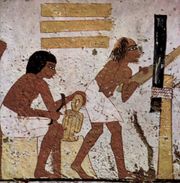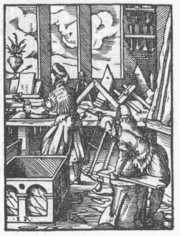Woodworking
2007 Schools Wikipedia Selection. Related subjects: Engineering

Woodworking is the process of building, making or carving something using wood.
History
Along with stone, mud, and animal parts, wood was certainly one of the first materials worked by primitive human beings. Microwear analysis of the Mousterian stone tools used by the Neanderthals show that many were used to work wood. Indeed, the development of civilization was closely tied to the development of increasingly greater degrees of skill in working these materials.
Among early finds of wooden tools are the worked sticks from Kalambo Falls, Clacton-on-Sea and Lehringen. The spears from Schöningen (Germany) provide some of the first examples of wooden hunting gear. Flint tools were used for carving. Since Neolithic times, carved wooden vessels are known, for example from the Linear Pottery culture wells at Kückhofen and Eythra. Examples of Bronze Age wood-carving include trees worked into coffins from northern Germany and Denmark, and wooden folding-chairs. The site of Fellbach-Schmieden in Germany has provided fine examples of wooden animal statues from the Iron Age. Wooden idols from the La Tène period are known from a sanctuary at the source of the Seine in France.
Two ancient civilizations that used woodworking were the Egyptians and the Chinese. Woodworking is depicted in many ancient Egyptian drawings, and a considerable amount of ancient Egyptian furniture (such as stools, chairs, tables, beds, chests) has been preserved in tombs. As well, the inner coffins found in the tombs were also made of wood. The metal used by the Egyptians for woodworking tools was originally copper and eventually, after 2000 BC bronze as ironworking was unknown until much later. Commonly used woodworking tools included axes, adzes, chisels, pull saws, and bow drills. Mortise and tenon joints are attested from the earliest Presynastic period. These joints were strengthened using pegs, dowels and leather or cord lashings. Animal glue came to be used only in the New Kingdom period. Ancient Egyptians invented the art of veneering and used varnishes whose composition is not known as finishes. Although different native acacias were used, as was the wood from the local sycomore and tamarisk trees, deforestation in the Nile valley resulted in the need for importation of wood, notably cedar, but also Aleppo pine, boxwood and oak, starting from the Second Dynasty.
The progenitors of Chinese woodworking are considered to be Lu Ban (魯班) and his wife Lady Yun, from the Spring and Autumn Period. Lu Ban is said to have brought the plane, chalkline, and other tools to China. His teachings are supposedly left behind in the book Lu Ban Jing (魯班經, "Manuscript of Lu Ban"), although it was written some 1500 years after his death. This book is filled largely with descriptions of dimensions for use in building various items—such as flower pots, tables, altars, etc.—and also contains extensive instructions concerning Feng Shui, the ancient Chinese practice of geomancy. It mentions almost nothing of the intricate glueless and nailless joinery for which Chinese furniture was so famous.
Tool sharpening
The cutting and some of the shaping woodworking tools rely upon sharp cutting edges to produce a satisfactory finish. Keeping these tools sharp is an important aspect of woodworking. There are a large number of machine powered and hand powered sharpening methods in use by woodworkers, the selection of which is in part determined by the tool being sharpened and part personal preference. Some tools, such as chisels and plane blades, are commonly sharpened by the owner, others, such as saw blades and machinery knives, are more often sent to a sharpening specialist.
Sharpening paraphernalia
- Diamond plate
- File
- Grinder
- Saw set
- Sharpening jig
- Waterstone
- Whetstone or Oil stone
- Grinding dresser
Sharpening methods
Scary sharp - a method using paper-backed coated abrasives or sandpaper and a flat surface, such as plate glass.
Woodworkers
- Alvar Aalto
- Norm Abram
- John Boson
- Mike Dunbar
- Tage Frid
- Eileen Gray
- Garrett Hack
- R. Bruce Hoadley
- James Krenov
- John Makepeace
- Sam Maloof
- David J. Marks
- Joseph Moxon
- George Nakashima
- Thomas Nixon
- Alan Peters
- Scott Phillips
- André Jacob Roubo
- Henry O. Studley
- Roy Underhill
- Sir Neville Wilkinson

